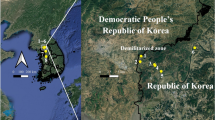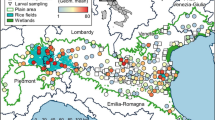Abstract
The innovation of ideas concerning the development of a strategy with cost-effective and easy use in mosquito control is recognized as an integral part of public health research. As the Aedes, Culex and Armigeres mosquitoes are considered as a vector for devastating parasites and pathogens, their identification is of primordial significance in the current scenario. The standard conventional methods become challenging in certain circumstances. Here we introduced the applicability of “Foldscope linked Geometric morphometrics” in mosquito taxonomy. MorphoJ Apache License (Version 2.0) and TpsDig232 were used for geometric morphometric analysis. The NucleoSpin® Tissue Kit (Macherey-Nagel) was used to extract the mosquito genomic DNA. The evolutionary distance calculation of respective specimens was performed using the neighbour joining method with the aid of MEGA X. The results from “Foldscope linked Geometric morphometrics” verified using mitochondrial COI gene-based characterization and revealed the presence of Aedes aegypti, Aedes albopictus and Armigeres subalbatus. The superimposition wireframe representation exposed prominent variation between the aforesaid mosquitoes. The principal component analysis exposed three distinct points in morphospace and precisely distinguished the two Aedes and Armigeres genera. The results gathered from this investigation could be executed in mosquito control research in the future to prevent vector-borne diseases.
Graphical abstract










Similar content being viewed by others
Data availability
The data analysed during the present investigation are available from the corresponding author on reasonable request.
References
Ajibowo AO, Ortiz JF, Alli A, Halan T, Kolawole OA (2021) Management of Japanese encephalitis: a current update. Cureus 13(4). https://doi.org/10.7759/cureus.14579
Anoopkumar A, Puthur S, Varghese P, Rebello S, Aneesh E (2017) Life cycle, bio-ecology and DNA barcoding of mosquitoes Aedes aegypti (Linnaeus) and Aedes albopictus (Skuse). J Commun Dis 49(3):32–41. https://doi.org/10.24321/0019.5138.201719
Anoopkumar AN, Puthur S, Rebello S, Aneesh EM (2019) Molecular characterization of Aedes, Culex, Anopheles, and Armigeres vector mosquitoes inferred by mitochondrial cytochrome oxidase I gene sequence analysis. Biologia 74(9):1125–1138. https://doi.org/10.2478/s11756-019-00231-0
Anoopkumar A, Aneesh EM, Sudhikumar AV (2020) Exploring the mode of action of isolated bioactive compounds by induced reactive oxygen species generation in Aedes aegypti: a microbes based double-edged weapon to fight against arboviral diseases. Int J Trop Insect Sci 40(3):573–585. https://doi.org/10.1007/s42690-020-00104-z
Ardkhongharn N, Ravichotikul R, Aksornchai P, Weluwanarak T, Chaiphongpachara T, Changbunjong T (2023) Wing geometric morphometrics to distinguish and identify Haematobosca flies (Diptera: Muscidae) from Thailand. Int J Parasitology: Parasites Wildl 21:74–82. https://doi.org/10.1016/j.ijppaw.2023.04.008
Brigitta Z (2023) Exploring the genetic diversity of mosquito-derived viruses in Central Europe with in vitro and molecular biological methods. Doctoral School of Biology and Sportbiology. University of Pécs
Chaiphongpachara T, Juijayen N, Chansukh KK (2018) Wing geometry analysis of Aedes aegypti (Diptera, Culicidae), a dengue virus vector, from multiple geographical locations of Samut Songkhram, Thailand. J Arthropod-Borne Dis 12(4):351. https://doi.org/10.18502/jad.v12i4.353
Chandrakanth P, Chandrakanth K (2020) Smartphone-based intraocular lens microscope. Indian J Ophthalmol 68(10):2213. https://doi.org/10.4103/ijo.IJO_2032_19
Chaves LF, Imanishi N, Hoshi T (2015) Population dynamics of Armigeres Subalbatus (Diptera: Culicidae) across a. Bull Entomol Res 105(5):589–597. https://doi.org/10.1017/S0007485315000474
Chen W-J, Dong C-F, Chiou L-Y, Chuang W-L (2000) Potential role of Armigeres Subalbatus (Diptera: Culicidae) in the transmission of Japanese encephalitis virus in the absence of rice culture on Liu-Chiu islet, Taiwan. J Med Entomol 37(1):108–113. https://doi.org/10.1603/0022-2585-37.1.108
Chiranjeevi S, Sadaati M, Deng ZK, Koushik J, Jubery TZ, Mueller D, Singh AK (2023) Deep learning powered real-time identification of insects using citizen science data. https://doi.org/10.48550/arXiv.2306.02507
Cybulski JS, Clements J, Prakash M (2014) Foldscope: origami-based paper microscope. PLoS ONE 9(6):e98781. https://doi.org/10.1371/journal.pone.0098781
Desai P, Awatiger MM, Angadi P (2023) Geometrics morphometrics in Craniofacial skeletal age Estimation-A systematic review. J Forensic Odonto-Stomatol, 41(1). https://ojs.iofos.eu/index.php/Journal/article/view/1509
Dey P (2023) Compound light microscope and other different microscopes. Basic and Advanced Laboratory Techniques in Histopathology and Cytology. Springer, pp 279–288. https://doi.org/10.1007/978-981-10-8252-8_24
Forattini OP (2002) Culicidologia Médica: Identificação, Biologia E Epidemiologia, 2nd edn. EdUSP, São Paulo
Jitsamai W, Piromkij P, Kamkong P, Chungpivat S, Taweethavonsawat P (2021) Seasonal distribution and environmental parameters associated with Brugia pahangi and dirofilaria immitis in naturally infected dogs in Bangkok and vicinity, Thailand. Sci Rep 11(1):1–6. https://doi.org/10.1038/s41598-021-84215-8
Liuti T, Dixon PM (2020) The use of the geometric morphometric method to illustrate shape difference in the skulls of different-aged horses. Vet Res Commun 44(3–4):137–145. https://doi.org/10.1007/s11259-020-09779-8
Lorenz C, Marques TC, Sallum MAM, Suesdek L (2012) Morphometrical diagnosis of the malaria vectors Anopheles cruzii, an. Homunculus and an. bellator. Parasites & Vectors 5(1):1–7. https://doi.org/10.1186/1756-3305-5-257
McNamara G, Difilippantonio MJ, Ried T (2005) Microscopy and image analysis. Curr Protocols Hum Genet 46(1):441–4434. https://doi.org/10.1002/cphg.42
Oliveira-Christe R, de Carvalho GC, Wilke ABB, Marrelli M (2023) Assessment of Wing Geometric Morphometrics of Urban Culex Quinquefasciatus (Diptera: Culicidae) Populations. Available at SSRN 4441461. https://doi.org/10.3390/insects11090567
Payne D (1988) Use and limitations of light microscopy for diagnosing malaria at the primary health care level. Bull World Health Organ, 66(5), 621. PMCID: PMC2491188; PMID: 2463112. Retrived from: https://www.ncbi.nlm.nih.gov/pmc/articles/PMC2491188/
Phanitchat T, Apiwathnasorn C, Sungvornyothin S, Samung Y, Dujardin S, Dujardin JP, Sumruayphol S (2019) Geometric morphometric analysis of the effect of temperature on wing size and shape in Aedes albopictus. Med Vet Entomol 33(4):476–484. https://doi.org/10.1111/mve.12385
Purwar P, Han S, Lee Y, Saha B, Sandhan T, Lee J (2019) High-resolution cost‐effective compact portable inverted light microscope. J Microsc 273(3):199–209. https://doi.org/10.1111/jmi.12775
Puthur S, Anoopkumar A, Rebello S, Aneesh EM (2018) Hypericum japonicum: a double-headed sword to combat vector control and cancer. Appl Biochem Biotechnol 186(1):1–11. https://doi.org/10.1007/s12010-018-2713-7
Richtsmeier JT, Deleon B, V., Lele SR (2002) The promise of geometric morphometrics. Am J Phys Anthropology: Official Publication Am Association Phys Anthropologists 119(S35):63–91. https://doi.org/10.1002/ajpa.10174
Suman DS, Shrivastava AR, Pant S, Parashar BD (2011) Differentiation of Aedes aegypti and Aedes albopictus (Diptera: Culicidae) with egg surface morphology and morphometrics using scanning electron microscopy. Arthropod Struct Dev 40(5):479–483. https://doi.org/10.1016/j.asd.2011.04.003
Tamura K (1992) Estimation of the number of nucleotide substitutions when there are strong transition-transversion and G + C-content biases. Mol Biol Evol 9(4):678–687. https://doi.org/10.1093/oxfordjournals.molbev.a040752
Thiele KR, Applequist WL, Renner SS, May TW, Dönmez AA, Groom Q, Yoon HS (2023) DNA sequences as types: a discussion paper from the special-purpose Committee established at the XIX International Botanical Congress in Shenzhen, China. Taxon. https://doi.org/10.1002/tax.12931
Acknowledgements
The authors Embalil Mathachan Aneesh thank DBT for funding (BT/PR39753/FCB/125/95/2020).
Funding
The study was funded by Department of Biotechnology (DBT) (BT/PR39753/FCB/125/95/2020), Department Of Science & Technology (DST/TDT/SHRI-02/2021 (G)), Govt. of India and Higher Education Department, (Chief Minister’s Nava Kerala Post- Doctoral Fellowship Program [II Batch 2022–2023 Mode II]), Government of Kerala.
Author information
Authors and Affiliations
Corresponding author
Ethics declarations
Ethics approval and consent to participate
This article does not contain any studies with human participants or animals performed by any of the authors.
Consent for publication
Not required.
Conflict of interest
The authors declare that they have no conflict of interest.
Additional information
Publisher’s Note
Springer Nature remains neutral with regard to jurisdictional claims in published maps and institutional affiliations.
Rights and permissions
Springer Nature or its licensor (e.g. a society or other partner) holds exclusive rights to this article under a publishing agreement with the author(s) or other rightsholder(s); author self-archiving of the accepted manuscript version of this article is solely governed by the terms of such publishing agreement and applicable law.
About this article
Cite this article
Mathachan Aneesh, E., Anoopkumar, A.N., Davis, D.M. et al. How steadfast is the concept of “Foldscope linked geometric morphometrics” for the identification of Aedes and Armigeres mosquito vectors?. Int J Trop Insect Sci 44, 789–800 (2024). https://doi.org/10.1007/s42690-024-01174-z
Received:
Accepted:
Published:
Issue Date:
DOI: https://doi.org/10.1007/s42690-024-01174-z




